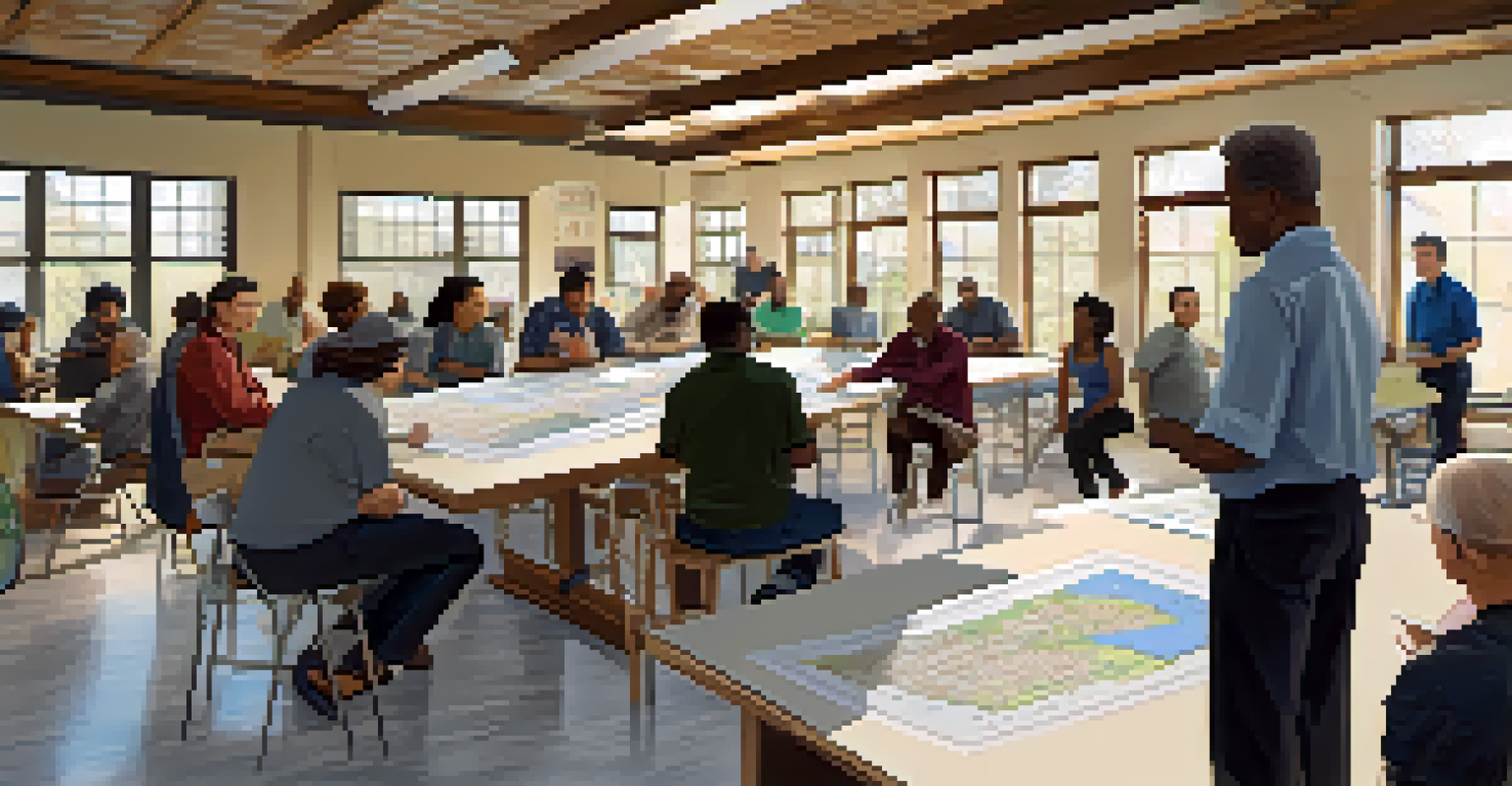Community Engagement in Detroit's Urban Planning Innovations

Understanding Urban Planning in Detroit's Context
Urban planning in Detroit has evolved significantly over the years, especially post-recession. The city has faced unique challenges, from economic decline to population loss, which have made innovative solutions essential. Understanding the local context is key to grasping how community engagement plays a role in shaping Detroit's urban landscape. By focusing on the community, planners can devise strategies that reflect the true needs and aspirations of residents.
The city is not a problem to be solved, but a canvas to be painted on.
In this framework, urban planning isn't just about buildings and roads; it's about creating spaces where people feel connected and valued. Engaging with community members allows planners to gather insights that statistics alone cannot provide. This participatory approach ensures that projects serve the public interest, enhancing the quality of life for all.
Ultimately, a successful urban planning initiative is one that resonates with the community it serves. By prioritizing local voices, Detroit is paving the way for a more inclusive and responsive urban development process.
The Role of Community Engagement in Urban Planning
Community engagement acts as the backbone of urban planning innovations in Detroit. Through workshops, town hall meetings, and online surveys, residents have the chance to voice their opinions and influence decisions. This collaborative spirit fosters a sense of ownership among community members, making them active participants rather than passive recipients of change.

For instance, when planning for public spaces, input from local residents can highlight the need for parks, recreational areas, or cultural amenities. By understanding the community's desires, planners can create spaces that truly reflect the identity and needs of Detroiters. This results in a more vibrant and cohesive urban environment, where residents feel a genuine connection to their surroundings.
Community Engagement Drives Change
Engaging residents in urban planning ensures that development reflects their needs and aspirations.
Moreover, by prioritizing community engagement, Detroit is setting a precedent for other cities. It showcases how listening to local voices can lead to innovative solutions that address real-life challenges faced by urban populations.
Innovative Tools for Community Engagement
Detroit has embraced various innovative tools to enhance community engagement in urban planning. Digital platforms, like interactive maps and mobile apps, allow residents to provide feedback easily and visually represent their ideas. This tech-savvy approach not only reaches a broader audience but also caters to younger generations who are accustomed to digital interactions.
Community engagement is the key to responsive urban planning that truly meets the needs of its residents.
Additionally, the use of social media has revolutionized how community members connect with planners. Platforms like Facebook and Twitter serve as conduits for dialogue, enabling instant communication and feedback loops. These tools help create an ongoing conversation about urban development, making it more responsive to community needs.
Ultimately, these innovative tools bridge the gap between planners and residents. By utilizing technology, Detroit is fostering a culture of transparency and inclusivity in urban planning.
Case Studies: Successful Engagement in Action
Several successful case studies illustrate the power of community engagement in Detroit's urban planning initiatives. One notable example is the revitalization of the Detroit Riverfront, which transformed an underutilized area into a vibrant public space. Through extensive community input, planners were able to incorporate features that residents wanted, such as parks, walking paths, and event spaces.
Another example is the Detroit Neighborhoods 2020 initiative, which focused on engaging residents in planning for their neighborhoods. By hosting community forums and gathering feedback, the city was able to tailor development projects to meet specific local needs. This initiative not only improved neighborhood conditions but also strengthened community bonds.
Innovative Tools Enhance Participation
Digital platforms and social media have transformed how community members connect with planners, fostering ongoing dialogue.
These examples highlight how community engagement can lead to tangible improvements in urban planning. When residents are actively involved, the outcomes are more likely to align with their expectations and enhance the overall livability of the city.
Challenges in Community Engagement Efforts
Despite its successes, community engagement in Detroit's urban planning is not without challenges. One major hurdle is ensuring that all voices are heard, especially those from marginalized communities. It's crucial to create an inclusive environment where everyone feels comfortable sharing their perspectives, but this can be difficult in practice.
Additionally, there can be a disconnect between community input and the final decisions made by planners. Sometimes, valuable feedback might not be implemented due to budget constraints or bureaucratic processes. This can lead to frustration among residents, who may feel their voices have been ignored despite their efforts to engage.
Addressing these challenges requires ongoing commitment and creativity. By continuously refining engagement strategies and ensuring transparency in decision-making, Detroit can foster a more inclusive planning process.
The Future of Community Engagement in Detroit
Looking ahead, the future of community engagement in Detroit's urban planning appears promising. As the city continues to innovate, there's a growing recognition of the importance of involving residents in shaping their environment. This shift is not just a trend but a fundamental change in how planning processes are conducted.
Moreover, as new technologies emerge, opportunities for engagement will expand even further. Virtual reality, for example, could allow residents to visualize proposed developments in immersive ways, fostering deeper understanding and feedback. Such advancements can democratize the planning process, making it accessible to an even wider audience.
Challenges in Inclusivity Remain
Ensuring all voices are heard, particularly from marginalized communities, is a crucial challenge in community engagement efforts.
Ultimately, a commitment to community engagement will be crucial for Detroit's sustainable development. By valuing local input, the city can ensure that its urban planning efforts meet the diverse needs of its residents while fostering a stronger sense of community.
Conclusion: Community Engagement as a Catalyst for Change
In conclusion, community engagement is not just a checkbox in Detroit's urban planning process; it's a catalyst for meaningful change. By actively involving residents, the city can create vibrant spaces that reflect the aspirations of its people. This collaborative approach leads to innovative solutions that address real challenges and enhance the quality of life.
As Detroit continues to evolve, the commitment to community participation will be essential in shaping the city's future. The lessons learned from past initiatives can guide the way forward, ensuring that residents remain at the heart of planning efforts.

Ultimately, the strength of Detroit's urban planning innovations lies in its people. By valuing community voices, the city can build a more inclusive, sustainable, and engaged urban environment.